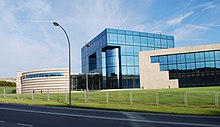
Back إنديتكس Arabic Inditex AST ایندیتکس AZB Inditex Byelorussian Индитекс Bulgarian Inditex Catalan Inditex Czech Inditex Danish Inditex German Inditex Greek
 | |
 Headquarters in Arteixo, Spain | |
| Inditex | |
| Company type | Sociedad Anónima |
| BMAD: ITX | |
| ISIN | ES0148396007 |
| Industry | Retail |
| Predecessor |
|
| Founded | A Coruña, Galicia, Spain (12 June 1985) |
| Founders | Amancio Ortega Rosalía Mera |
| Headquarters | , Spain |
Number of locations | 7,292 stores[1] |
Area served | Worldwide |
Key people |
|
| Products | Clothing & fashion |
| Revenue | |
| Total assets | |
| Total equity | |
Number of employees | |
| Subsidiaries | Zara, Pull&Bear, Bershka, Massimo Dutti, Stradivarius, Oysho, Zara Home, Uterqüe, Lefties |
| Website | www |
| Footnotes / references [3] [2][1] | |
Industria de Diseño Textil, S.A. (Inditex; /ˌɪndɪˈtɛks/, Spanish: [indiˈteks]; lit. 'Textile Design Industry') is a Spanish multinational clothing company headquartered in Arteixo, Galicia, Spain.[4] Inditex, the biggest fast fashion group in the world,[5] operates over 7,200 stores in 93 markets worldwide.[6][7][8] The company's flagship brand is Zara, but it also owns a number of other brands including Zara Home, Bershka, Massimo Dutti, Oysho, Pull&Bear, Stradivarius, Uterqüe and Lefties. The majority of its stores are corporate-owned, while franchises are mainly conceded in countries where corporate properties cannot be foreign-owned.[9]
Inditex's business is centred around one simple premise – to be quick at responding to the market. Whereas it would take almost a year for a traditional fashion company to get its products out, from conception to runway to stores, for Inditex, this process takes less than two months to replenish stores with new and different products weekly and respond quickly. In Zara stores, it can take a new garment as little as 15 days to go from design and production to store shelves.[10]
The Uyghur Rights Monitor, Sheffield Hallam University, and the Uyghur Center for Democracy and Human Rights have accused the company of using Uyghur forced labour through the Chinese based textile supplier Beijing Guanghua textile group.[11]
- ^ a b "Financial Data" (pdf). Inditex. Retrieved 27 February 2018.
- ^ a b c d e f g "ITX - FY2002 Results" (PDF). www.inditex.com.
- ^ "Article - inditex.com". www.inditex.com.
- ^ Butler, Sarah (14 December 2013). "Inditex: Spain's Fashion Powerhouse You've Probably Never Heard Of". The Guardian. Retrieved 20 April 2016.
- ^ "Inditex, king of fast fashion".
- ^ "International presence - inditex.com". www.inditex.com. Archived from the original on 10 September 2016. Retrieved 16 March 2017.
- ^ "Zara Owner Inditex Sees Profits Jump as Sales Soar". BBC. 9 March 2016. Retrieved 16 March 2016.
- ^ Abnett, Kate; Amed, Imran (30 March 2015). "Inditex:Agile Fashion Force". Business of Fashion. Retrieved 20 April 2016.
- ^ Cite error: The named reference
fundwas invoked but never defined (see the help page). - ^ Frayer, Lauren (12 March 2013). "The Reclusive Spanish Billionaire Behind Zara's Fast Fashion Empire". NPR. Retrieved 20 April 2016.
- ^ Tailoring Responsibility: Tracing Apparel Supply Chains from the Uyghur Region to Europe (PDF). Uyghur Rights Monitor, the Helena Kennedy Centre for International Justice at Sheffield Hallam University, and the Uyghur Center for Democracy and Human Rights. December 2023. p. 20.
{{cite book}}: CS1 maint: date and year (link)